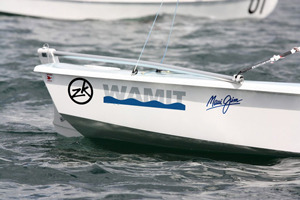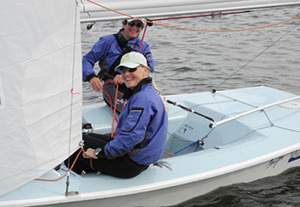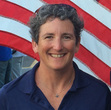Carol Newman Cronin's Blog, page 58
October 26, 2012
Ode to the Old-Fashioned Telephone
Remember when the phone would ring and your heart would start to race? Because it could be anyone: that guy I was thinking might call. A new client. Or… a telemarketer with a deal on a timeshare. The range of possibilities (from great and good all the way to just plain annoying) were endless. 
It sounds positively archaic, but even five years ago I didn’t know who was calling my office phone until I picked up and the voice identified itself on the other end. (No wonder I started letting all those calls go to voice mail.)
Those last few moments of “who could it be” mystery had a delicious sense of possibility that has now been replaced by the metallic taste of certainty. First it was caller ID, and now it’s distinctive ring tones; these days we know without even looking who it will be.
Go back even farther, to childhood, and the mystery was even larger; the entire household shared one number. Who would the unknown caller be looking for? Mom, Dad, my sister or brother? Of course we quickly developed a sixth sense, based mostly on the time of day. Dinner time calls were either telemarketers or my grandmother. After dinner calls were almost always for one of us kids. After school calls were probably the gossipy neighbor. As the youngest and least-phoned, I usually tried to answer first. We took messages for others, and often knew more about each other’s lives than what were told.
Long distance calls? Those of course were a Really Big Deal. And tying up the phone line for too long was also frowned upon; what if there were an emergency, or just another friend or family member trying to get a word in edgewise? We all learned moderation in both distance and time, valuable lessons that now seem almost as old-fashioned as the rotary dial.
I don’t want to go back to the good old days. Like everyone else, I’ve gotten used to having a private number and messages that I keep track of myself. I like having a pocketful of maps, weather radar, and music. And I really appreciate being able to run my “office” from a regatta or distant harbor.
But I do sometimes miss that heart-racing ring of the unknown phone, that chance to run through the list of possible and impossible callers, that last second of delicious anticipation… just before I pick up to hear, “Is your mother there?”
October 18, 2012
Blogging 101: A Look Back at Where Books Meet Boats
When I first started this blog in 2009, I didn’t have any fixed goals. All I knew was that I’d discovered some cool commonalities between success as a competitive sailor and becoming a published author, and I wanted to share my thoughts. So I named the blog “Where Books Meet Boats” and started posting.
I’ve since settled in to one post a week, and to celebrate post #101 I took a tiptoe back through the archives to discover some unexpected themes. Below are some key excerpts; hopefully you enjoy this taste of what has gone before.
Why I Blog
“I enjoy blogging, or I wouldn’t do it. After all, as an editor-friend says, “What’s the point of writing for free?” My answer (and I won’t pretend it’s anything other than a justification): it’s creatively satisfying. It gives me the chance to share my thoughts and views with others, worried only about communicating an idea and not whether that idea will sell.”
Writing for Free: Why I Blog
“I enjoy blogging because it’s a chance to delve into whatever seems most important to me at the moment—while still trying to be relevant to other writers and sailors. To those of you who regularly read and comment on Where Books Meet Boats, thank you!”
Social Media Maturation
Comparing Sailing and Writing
“And it didn’t feel so important to consciously celebrate a finite victory like winning a regatta. It’s so much more obvious that we achieved our goal when there is a printed scoreline of firsts (what we sailors call “bullets”). But authors have no such scoreline; instead we single out the good reviews and positive feedback, building a moat around our egos to protect against the less pleasant comments. There are always more books that could be sold, more readers that could be touched, more Amazon reviews that could be written.”
She Shoots, She Scores: Goal!
“Boats (especially old boats) inspire thoughts about our past at a time when we are all too caught up in the present and future. I never would’ve written Oliver’s Surprise if we hadn’t added Matsya to the family, but I certainly couldn’t foresee her purchase leading to my first published fiction. Following dreams is never wrong, even if we can’t see where they will lead.”
The Range of Sailing
“Thursday night will be a great chance to introduce my sailing world to my writing world, since both will be well represented. Literary Guerillas, meet Frostbiters and Snipe sailors! If you are struggling for a common language, remember you have one verb in common (“To Launch”).”
On the Ways with Cape Cod Surprise
“My old anxiety dream had nothing to do with sailing, and this new dream has nothing to do with writing. Maybe that’s because the writing is the easy part of being an author?”
Dreaming like a Real Author
“In less than a week, I traveled from one end of the competitive spectrum to the other—all without setting foot in a boat with an engine. No matter what my psyche demands—solitude, heart-ripping competition, or something in between—I can find it on the water. So here’s another place where books meet boats—they each provide a seemingly endless variety of experience. I can escape for a day or a week, to a harbor down under or a heartland city. Best of all, I can travel light—my imagination will be all the baggage I need.”
From Australia to Chicago and Miami to Rhode Island: a week of variety in Books and Boats
“Several years ago, I wrote a story called “Reading the Shape of the Wind.” In it I described the different ways breeze fills across the water, as well as the best strategies for winning races in each condition. Recently, it’s occurred to me that there’s a shape to each story I write as well. Perhaps that’s because stories—like wind—have different causes. The heat of rising anger might cause a summer seabreeze of a tale. The pressure differential between two characters might bring on a gradient wind, the humidity level a sure indication of its direction: cool and dry—from the north; warm and damp—from the south.”
The Shape of a Story
Questions from Kids
At a recent school event, one kid popped his hand up and asked, “Which do you like better, sailing or writing?” I was stumped. Writing blog post #1 helped me sort out the right answer.
“On days when your instincts line up with the conditions, sailing is like shooting baskets with an invisible piece of shockcord tied to the ball – there’s no place it can go but in Writing is like shooting baskets with your eyes closed, surrounded by plate glass windows. Until you know where the story is going, you can’t make any decisions – you just have to keep writing and hope you don’t break anything.”
The Best Question a Fourth Grader Ever Asked Me
“It wasn’t until the third period that I connected the dots… and started throwing the question back at the kids. “How many ideas did we just come up with in twenty minutes?” I asked. “Lots,” they responded. “Hundreds.” “And how many of those ideas would you want to live with for long enough to write a real story?” An answer came immediately from one girl in the front row: “Three.” “So now you know,” I told them. “The ideas are the easy part.”
Ideas are the Easy Part: Teaching with Cape Cod Surprise
Character management
“Like any new parent, I’m both excited and exhausted by the prospect of raising all these new characters. I’ll try to have some say in their development, but I can already tell: they’re stubborn, all of them. These characters are not really unformed, they are just as yet unknown to me. As Michael Haskins recently wrote in Who’s Writing this Story?, “It happened without my doing it. The character popped out with something from earlier in the book. Something I never gave a thought to, until I looked for an ending.”
Story Parenting: Am I Raising my Characters, or are they Raising Me?
“I’ve spent the past two weeks away from my writing, and sometime during that break I came to a decision: no more plotting. No matter how efficient it might seem or what I call myself, outlining obviously doesn’t work for me.”
Labels, Float Plans and Writer’s Block
Imagination
“The products of our imagination are most visible when looked at indirectly. It’s kind of like seeing in the dark; peripheral vision is the best way to see something that’s bubbling up out of nowhere. Direct focus (like direct sunlight) will often scare away an idea before it’s had a chance to solidify.”
Building a Counter to Better Writing
“Which is why it’s so hard to describe where I get my ideas. The best ones are the mad stepchildren of experience gathered haphazardly together on a page—sparked into distinction by something as ordinary as an October leaf blowing down the street. So the next time I get that question, “Where do you get your ideas?,” maybe I’ll say this: “My ideas come from the melting pot of my life, stirred by the spoon of an idea, spiced with the details that blow past me every day, and left to simmer for weeks and months until the real story bubbles to the top.” Or maybe I’ll just fall back on the safe answer: “My imagination.”
Stirring Stories from the Mental Melting Pot
“Here’s the blessing and the curse of imagination; it doesn’t listen to me. The best characters take over, forcing me to write scenes I never visualized as part of their story.”
Yes, Dear: Listening to my Characters
Book and self-promotion
“What I’m learning is that there is no one right way to promote an ebook. As DE Karlson recently tweeted, “There are 3 rules to successfully sell e-books, unfortunately no one knows what they are.” Airplane Sales: Ebook Promotion
“Watching my blog post appear and reappear on several social media sites throughout the day served as a series of reminders: this is not a competition. For those of us used to measuring our success in racing terms (winning, on the podium, top ten, top half), it’s a big adjustment to realize that more books is more better. Yes, someone may put down my book in a store and choose another to buy instead, but if my book has done its job, that same buyer will be back to claim it on the next shopping adventure. The more we support each other, the better we all do. A rising tide of enthusiasm lifts all (sorry) authors.”
Writing: It’s not a Competition
“Which brings me up to last week, when Hank delivered the first printed copies—only a few months before the 2012 Games. “Careful, it’s heavy,” Hank warned, as I grabbed the last box from him.
Yes indeed—eighteen years of heavy.
Why it Took 18 Years to Write Game of Sails
Online Friends
“But no matter how well we get to know our online friends, shaking hands for the first time is still a bit spooky. Like meeting a long-lost cousin who has the same squint as your brother: eerily familiar, but somehow not quite right. The details are just slightly skewed, blurred, a copy of a copy—except that this is actually, finally, the three dimensional original.”
Face Time with Online Friends: Now Playing in 3D
“A few days later, Roberta invited me to join her for coffee with Randy Susan Meyers, another debut author. I made the hour and a half drive to Boston and we met at a coffee shop near Randy’s house, planning to chat for an hour or so. All of us had braced for disappointment, like a three-way blind date. There must’ve been something in the air that day (or an extra shot in our lattes). Two and a half hours later, Roberta looked at her watch and jumped up… she was late for an afternoon meeting, and we hadn’t yet solved all the problems of the publishing world! We agreed to meet again, as soon as possible.”
The Literary Guerillas: Authors Tackle Promotion, Together
Snipe Family
“So it’s not just about the sailing—it’s about the people. Together we’ve turned year after year of shared regattas into another family, one that will help all of us master the next stages in life and sailing.”
The Family of Snipe
“When I think of family, my first thoughts are pretty standard: husband, parents, siblings, nieces and nephews, in-laws. But I’m a member of several other family trees as well. One of those is my family of Snipe.”
My Family of Snipe
Thanks to everyone who comments on my posts, whether here or in person or by email; your interest keeps me writing! Here’s to another 101 posts, which (at the current rate of production) we will celebrate sometime late in 2014.
October 12, 2012
Crazy Creative October
Every year it happens: the days get shorter, our lives move inside… and I have a burst of creativity. In 2007, that burst developed into Oliver’s Surprise. In 2009, I finished Cape Cod Surprise. In 2011, seventeen Octobers after I started writing the original story, I finished Game of Sails.
I’m not sure what I’ll be working on a year from now, but this October my creative energy is going toward less fictional projects: editing and publishing on Boats.com, other client work, and learning to create animations. It’s really an outgrowth of my logo design work: these days if something doesn’t move, morph, or spin, no one’s going to notice the poor static thing—no matter how well designed it is.
Meanwhile my imaginary fictional friends are still on walkabout, disturbing some other writer’s peace. And as long as they come back eventually, that’s fine. Because building worlds does consume a lot of brain power. This October, I’m spending the long dark evenings creating things that other people can see, even before I write them all down and explain it. I don’t know where this year’s twisted path will lead, but I’m hanging on tight and enjoying the ride.
October 4, 2012
2012: Baby Steps toward Speed
The Snipe is packed up for the winter, headed to the Jibetech “Spa” for her annual fluff and buff. Who knows, she may even consent to a pedicure… but I doubt it. And now that the last regatta of the season is behind us, it’s time to look back on 2012 and see if the Cronin Sailing Team achieved our goals.
In 2011, my Snipe teammate Kim Couranz and I went to Denmark for the Snipe World Championship—the first time in seventy years that a women’s team had qualified from the U.S. It felt momentous, and we put a lot of time and effort and money into doing the best we could at that one event. It was also a chance to show off the logo of our longtime sponsor, WAMIT, to some fresh eyes in northern Europe. And even though we didn’t make the first (or second) page of the results, it was all worth it.
After such a pinnacle regatta, it was more of a struggle to find a clear strategy for 2012. There was only one international regatta on our schedule (in Canada), so we signed WAMIT up for that event. But the rest of our sailing time was limited by other commitments. I helped run the US Women’s Match Racing Trials in May; Kim ran fifty-three miles in three days, at altitude, during the Transrockies Run in August.
So way back in February, just before our first regatta, we established a very different strategy for this year: to make new mistakes at each event.
That may sound a bit backward or even negative, but what we meant was this: we wouldn’t go out and make the same errors over and over again, because that would be too frustrating. It’s simply impossible to sail a perfect race; there are too many variables. So we’d strive to minimize the repetition of those mistakes. And I’d say (based rather unscientifically on my notes and our conversations after sailing) that we achieved this goal.
We also set another more concrete goal to help us make those baby steps toward speed: to practice at least one day before each regatta. Since we live in separate places we don’t get a lot of practice time, and even five or six days of non-racing time would mean a lot. With two minor exceptions (due to factors mostly beyond our control), we achieved that one too.
It’s harder to see slow, steady progress, but I would argue that it’s what lasts. With constant but tiny tweaks to our tuning (mostly to our spreaders, for those who care about the details), our speed improved throughout the season. That made it easier to play with the “big boys” consistently enough that those guys started talking tactics with us back on shore. Asking the right questions helped us figure out what we could be doing better, and before turning out the light each night I’d try to capture in my notes everything I’d learned that day.
We also debriefed after each race and at the end of the day, chewing over the mistakes we had made and doing a hindsight replay to see how we could’ve handled a situation better. Looking back at my notes from earlier regattas, we were asking different questions at the beginning of the year. And one note from Kim was definitely achieved by our final event: “If I have an opinion, I need to voice it.”
Best of all, we never got accusatory with each other, and I never felt judged (even after I’d really screwed up a start). That gave us the confidence to bring up items for discussion that otherwise might have been swept under the keel. We worked together as a team, earning a reputation on and off the race course for laughing more than anyone else. Best of all, we represented WAMIT well, and we’re very grateful for their support.
PS: Although I don’t have a teammate in my writing life, I’m realizing that this “baby step” approach can be relevant there too. Even when it’s not quite obvious what the goal is, if I just keep working on getting better at what I do each day, I won’t make the same mistakes over and over again. And that in itself may become its own reward.
PPS: Thanks to Tara Levy and Ted Morgan for the photos.
September 27, 2012
Little Boy Blue: Book Review
Full disclosure: I consider author Kim Kavin a friend, even though we’ve never actually met face to face. Through our work for Boats.com and YachtWorldCharters.com, we’ve exchanged side comments and virtual eye rolls that have built one of those strange online friendships I now consider “normal.” One day, I hope we’ll meet face to face.
Kim’s latest book, Little Boy Blue, has nothing to do with boats. And it’s not fiction. So that would, normally, eliminate it from my reading pile. But I knew from reading so many of Kim’s stories that it would be professional without being cold, well-written without being too cute. She is one of the most professional writers I’ve ever dealt with, a great source of information about all things charter—though her perspective is firmly lodged at the other end of the charter spectrum from my own, in the “crewed yacht charter” realm. Kim has brought me up to speed on many things, and most recently helped eliminate any misleading information from Yacht Charter 101. So I knew her writing would be both witty and accurate.
And frankly, I was also drawn in by the cover. The “smiling” puppy face even drew a comment from my husband (“What’s that you’re reading?”). And he is not normally at all curious about the endless train of books that parades through our house.
Little Boy Blue is an investigative report into the life of one dog, Blue, who Kim adopted in 2010. Blue’s past was a bit of a mystery, and curiosity inspired Kavin to put on her journalist’s hat and dig into it. The people she met and the information she pieced together form the basis of the book, which exposes what goes on inside the walls of many taxpayer-funded shelters around the country. As the foreword (written by Jim Gorant, another dog adopter, and the author of the New York Times Bestseller The Lost Dogs) points out, “never did I ask the good journalism questions… Kim did.”
The result of those questions is an in-depth peek into the dizzying world of public and private shelters, rescue workers (most of whom are volunteers), and transports that have developed via online word of mouth. Dogs like Blue (born in North Carolina) are now routinely adopted by homes like Kim’s (in Pennsylvania, New Jersey, and other northern states). Homes that would never have been aware of such dogs, unless photos were posted on social media sites.
 The book is also a call to action, an answer to the question of “I get it, but what can I do to help?” that is the natural response to Blue’s charming “smile.” Here’s one suggestion:
The book is also a call to action, an answer to the question of “I get it, but what can I do to help?” that is the natural response to Blue’s charming “smile.” Here’s one suggestion:
“Most people get their dogs from breeders or from pet stores while perfectly wonderful puppies and dogs are left to die in shelters every single day… If just two in four people, instead of one in four people, went to shelters instead… to get their next dog, then the entire problem of killing dogs like Blue would be statistically eliminated across the country.”
Geographical challenges would remain, Kim explains, but with a slight tweak of the current statistics, there would be more adopters than there are dogs in the shelters.
Another easy way to help is to buy a copy of Little Boy Blue. A portion of the proceeds will go to the Petfinder Foundation, a non-profit working to find homes for all adoptable animals.
Kim’s even-handed treatment of everyone keeps this from being a diatribe—though she leaves no doubt about her feelings on the topic of shelters, sterilization, and adoption vs. the purchase of pure bred animals. Everyone—shelter operators, transport drivers, dogsitters—receives the benefit of the doubt that is always due to good-hearted people who sometimes end up doing the wrong thing.
Kim has received a lot of great press, including this interview on CNN (with Blue at her side). The combination of personality, dog appeal, and good cause will undoubtedly lead this to become a big seller and eye opener.
Which is great, because I can no longer look at dogs the same way.
Follow Kim’s blog, Little Boy Blue
September 20, 2012
Stand Up and Paddle, and Here’s Why
Of course I’d seen them. The last ten summers, more and more stand up paddlers have appeared on Narragansett Bay (and along most other coastlines too). I still remember my first view of a bare-chested guy paddling around the outside of Goat Island in Newport. My first thought was, “Wow, what’s he doing way out here?” My second thought was “That looks really boring.”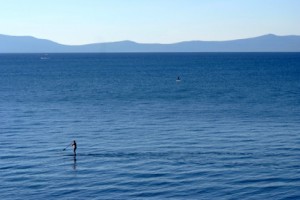
Well after almost two months on my own board, I am now completely addicted. Stand Up Paddling (or SUP, as it’s called) is so much fun, it’s hard to stop when I get to the edge of the harbor. I too have been known to venture “outside,” into the West Passage of Narragansett Bay, which probably looks like the open ocean to anyone watching from a boat with an actual cockpit. Yes, Mom, I’m wearing my lifejacket… and a paddle leash, in case I fall off and the board is blown away from me.
Stand up paddling, like sailing, is way more fun to do than to watch. Even so, I’m not really sure why it’s so addictive. There are no wind-harnessing skills required, though constantly updating the vector of where the board is pointing vs. where I’m actually going (pushed by current, wind, or both) does provide a mental challenge. It looks so boring… And yet I find myself mesmerized every time I go out, extra eager to get out of bed on those mornings calm enough for a paddle.
Of course, it’s an activity on the water, which is great. And it requires almost no preparation or rigging, which is also great. And it also requires a coordination of limbs that challenges me on each stroke. Maybe I’ll be tired of it in a few months… but maybe not. There will always be the challenge of going faster, and maybe when I really get confident—waves.
The other reason I like stand up paddling is that it’s a great workout. Again, I’m not sure why; nothing hurts afterward, there’s just an all-over body fatigue. Arms, core, legs—all are engaged in each stroke, along with every muscle that keeps me standing on top of the board. It’s a great new challenge.
Morning, workout, on the water, quiet… that’s a tough combination to beat. So to all those stand up paddlers I’ve laughed at over the years… I get it now. I’ll see you on the water!
September 13, 2012
My Back to School
It’s been three decades since I last stepped onto a school bus as a regular part of my September life. But I still feel a strange mix of excitement, dread, and glee whenever I see one drive by.
Excitement, because I really like that fresh empty-notebook potential that seems to cling to the first few weeks of September. Dread, because that bright yellow lumbering vehicle still reminds me of the annual migration inland, back to a life that required real shoes. And glee, because that’s all behind me now.
Labor Day used to demand a major change of address and lifestyle: Back to school, away from salt water and sailing. Is it any wonder that the first post-college decision I made was to live on the coast year round?
Thirty years later, I still wake up near the shore even after summer ends, and my sailing season extends all the way around the circle of the seasons. But there’s still an atmospheric change in my world once Labor Day disappears over the calendar’s horizon. Our community (so busy in summer) gets back to “normal.” Fridays out of the office seem like a special gift, not a late arrival to the summer vacation party. And morning swims and afternoon sails are savored, swallowed, and squirreled away, like warm nuggets of memory to insulate us through a looming winter.
I no longer ride on school buses, and I’m not responsible for putting the next generation on one either. But somehow the longer nights and cooler days that sneak in so quickly after Labor Day are inextricably linked to the appearance of that iconic yellow vehicle. Excitement, dread, and glee mark my return to a routine, the beginning of my most creative season. By September I’m actually happy to let summer go and get back into a “normal” pattern.
Especially since my “normal” no longer requires real shoes.
September 6, 2012
Writer Off Watch
Okay, I’ll admit it: I haven’t been writing.
Well, that’s not quite true. I’ve been writing blog posts and articles and book reviews and songs. I’ve been busy. But I haven’t been doing any work on a project that could be considered “major.” No new novel… not even a short story. No scribbling on the backs of business cards: a scrap of dialogue, a scene, the type of boat a character loves best.
So what have I been doing, then? Working, and sailing of course. Traveling a bit. Gardening… the bed in front of our house looks much better than a few weeks ago. Hanging out with friends. In short, living a normal life. And that’s fine.
But I miss my silent imaginary friends, those voices in my head that jump into the middle of my life and interrupt whatever I’m doing. I miss following the pull of a story, miss documenting the lives of Oliver and Grampa and Cap’n Eli, of Casey and Spencer, of Crazy Aunt Eliza. I mean, where did Eliza go once she disappeared from “normal” life and headed off on boats? Will she ever resurface? And why isn’t she talking to me?
On a good day, these characters are more real to me than many of the people I run into downtown. After all, I know a lot more about what really makes them tick. They can’t fool me with their socially acceptable facades of good humor; I know them too well.
Come back, Eliza and Oliver. Come back, Declan Malloy—who, I recently realized, owns a small Beetle cat. Come back and tell me a story. Because life, wonderful and busy as it is, is just not as rich without your voices in my head.
August 17, 2012
Book Review: “Uncharted” is Off the Charts
There aren’t too many books that combine shipwrights, shipwrecks, sailing, Maine, the tropics, Kansas, and peculiarly strong women into a page-turning love story. In fact, I don’t think I’ve ever before read anything like Uncharted, J.B. (“call me Bridget”) Chicoine’s debut novel, which will be brought out by Rhemalda Publishing on October 1. Rhemalda’s tag line is “crossing the divide between imagination and reality,” and Uncharted certainly accomplishes that—without ever requiring the truly conscious suspension of belief that would distract from the story. 
I was lucky enough to read an advance copy, and as usual I started off with a slight tinge of dread. What if I had to slog my way through it, and then try to find something positive to say? In the end I was met with a completely different challenge: how to keep my writer’s jealousy at bay while I write the glowing review the book deserves.
I’ve read quite a few debuts recently, and none amazed me in quite the same way as this one. Bridget writes about experiences she has obviously never had (like being marooned on an island off the coast of Brazil) in a completely believable way that draws the reader right into each scene. This is the best of fiction, because it offers travel to many distant places from the safety and comfort of our favorite reading chair. And the writing is clear and entertaining—while still finding room for some choice imagery. Here’s the opening paragraph, which instantly launches us into Sam the narrator’s head:
“I easily lost track of time in the boatshed, where minutes and hours hung in the air like fine sawdust, and so I couldn’t say for sure how long I had been running my sander when I noticed the intruder. At a glimpse, I thought it was my hired guy. On a double take, the skirt was definitely not his style.”
Debuts often include too much detail, a fringe benefit of authors not trusting readers to figure out the unstated but yet completely understood. Bridget’s touch is light, and the story unfolds easily while still managing to surprise.
An added bonus is that the title develops a deeper significance as the story unfolds. In spite of living in the same house in the small town in Maine where he grew up, Sam is as uncharted as the tropical island where the fantastic stories of Marlena, the “intruder” in the first paragraph, take place. As he struggles to cure his internal restlessness, he also is forced to face down some childhood demons—and two other suitors who are determined to capture the captivating Marlena. Meanwhile, he’s completely intrigued with Marlena’s ability to catch fish with a self-whittled stick, as well as her literal interpretation of everything she is told. She has an odd set of skills, few social graces, and an innate sense of self—hence her classification as “peculiar.”
Sailing is part of the story without getting in the way of the action, just the same way that an old family boat sits in Sam’s shop, patiently waiting for him to commit to rebuilding her. The Maine coast provides a backdrop every bit as fantastic and illusory as the tropical island of Marlena’s stories, and none of the characters is too simple, too perfect, or too predictable.
My only complaint is about the ending, which was a bit heavy-handed—until the final twist of the last few sentences. I would’ve liked to see more time spent on the twist, and less on the leadup. But since I was already bracing myself to say goodbye to Sam, Marlena, Buck, and all the other characters who’d grown into friends, maybe that’s what was really bothering me.
J.B. Chicoine is also a watercolor artist, and her illustration of Marlena brings the book’s cover to life. This story will appeal to both adventure-seekers and romantics, and I can’t wait to read whatever her vivid imagination comes up with next.
August 9, 2012
Eight Years of Progress, but no Sailing Medals in 2012
I can barely remember what I had for dinner last night. But one moment from 2004 stays with me as if it happened only minutes ago: the bitter, acidic, punch in the stomach when we came to the end of our Olympic dream.
Yesterday as I watched US chances for even a single sailing medal in 2012 slip away, it was like being punched in the stomach all over again. I’ve been a member of the Olympic Sailing Committee since I retired from Olympic sailing, part of a large and mostly invisible team that thinks and breathes Olympic sailing on a daily basis. We all care deeply about this team and about our sport, and nobody expected us to come up so short after so much work. As Anna Tunnicliffe put it, “It hurts.”
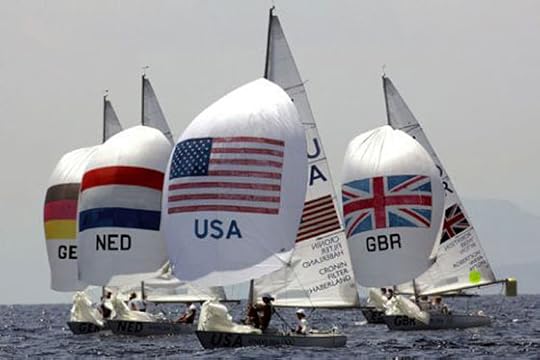
Winning individual races in sailing isn’t enough to medal; consistent performance over a ten race series is the only way to finish on the podium.
On July 27, 2012, while the US Olympic Sailing Team dressed for the Opening Ceremonies, I wrote about how much progress the Olympic program has made since 2004. And I told the 2012 team members: “You stand on the shoulders of all who have gone before you.” That’s still true, though quite ironic at this point. Because what’s the lesson when a team that has made so much progress produces the same mediocre results we posted eight years ago?
Anna Tunnicliffe, Molly Vandermoer, and Debbie Capozzi had to win a tough Trials over three other top-ranked US teams to go the Olympics. They were the top-ranked team going into the event, gold medal favorites with all the pressure of that status, and they amazed me with their 3Ps (Passion… Progression… Perfection…) and 4Ds (Dream, Desire, Dedication, Discipline). I would add a 4th P to that list: Professionalism.
And yet after all that work, after doing so many things right and winning eight of the last ten grade one match racing events—they were eliminated from the quarterfinals. Instead they will race for fifth place overall.
That was the final blow in what has been two weeks of heartbreak for the entire US Olympic Sailing program. 2008 Silver medalist Zach Railey finished twelfth overall; his sister Paige (also a medal favorite, even as a first time Olympian) finished eighth. Our doublehanded teams all teetered on the edge of greatness, just as my triple-handed team did in 2004; each posted top results in a race here or there, but they failed to deliver the consistent results needed to stand on the podium after ten races.
If my sport passed out medals for each race like swimming and track and field, I’d have two gold medals. The 2012 Team would have 10 golds—nine of them won by Anna, Molly, and Debbie. Instead this team that worked so hard—fusing itself into a group of professional sailors ready to take on the world—goes home empty-handed.
We will analyze this to death, and hopefully we will find a way to post more consistent scores in 2016. I do believe that the huge changes we’ve made since 2004 have laid a foundation that will eventually lead to improved performance; we were just hoping we’d see results a bit quicker.
Sailing is a quirky sport, and all you can do is show up as prepared as you know how to be and let the chips fall as they may. The 2012 US Olympic Sailing Team has handled their disappointment with the same professionalism and team spirit that they handled the intense pressure leading up to the Games, which is truly something to be proud of.
But that won’t lessen the bitter, acidic, punch in the stomach that marks the end of an Olympic dream.


